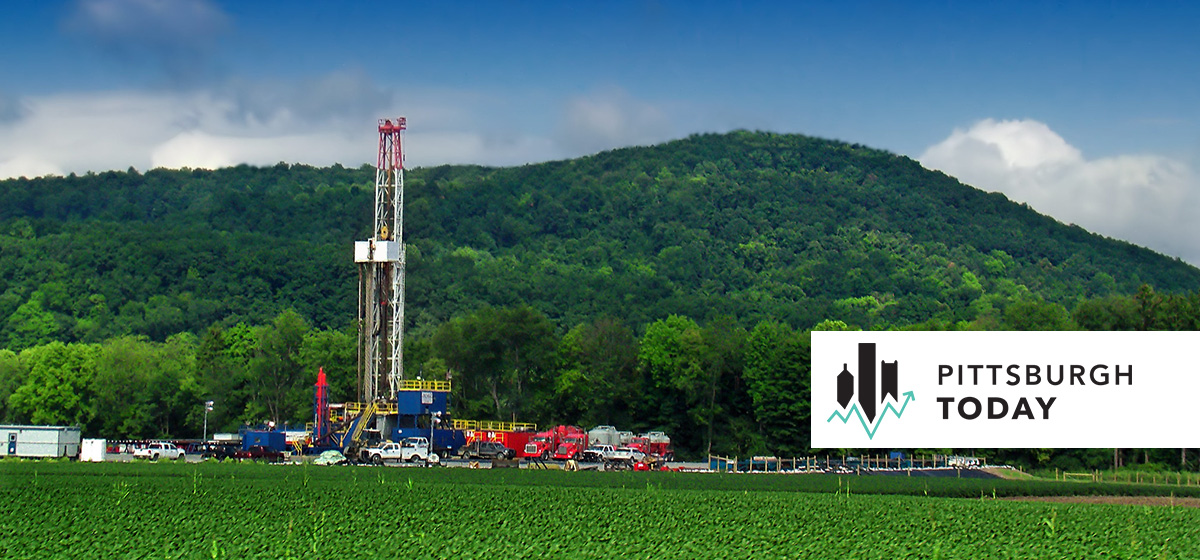Shale Gas Was in Trouble, Then Came the Coronavirus

Shale gas produced by Appalachian region wells slipped 1.8 percent during the last three months. But what seems like a slight decline warns of a coming storm for an industry that has seen production rise consistently—and sometimes dramatically—every year since the gas-rich Marcellus play drew companies to southwestern Pennsylvania in droves more than a decade ago.
The COVID-19 pandemic is contracting economies near and far, pushing nations into recession and slashing energy demand, natural gas included, as businesses are shuttered and people are told to stay at home.
Last month, the pandemic led Shell to suspend construction of its ethane cracker complex in Beaver County that economic development officials hope will trigger a robust petrochemical industry eager to buy abundant and inexpensive gas from local wells.
But storm clouds were gathering long before the coronavirus reached U.S. shores. An already vulnerable industry due to steeply falling energy prices was aggravated by a Saudi Arabia-Russia oil price war, a glut of natural gas, waning demand and operators burdened with heavy debt, which was incurred with the expectation that rising prices would make expansion worth the cost.
“There are so many headwinds against the industry right now,” said Corey Young, director of the Shale Gas Knowledge Hub at Washington and Jefferson College. “If you personify the industry, it wouldn’t be in critical condition, but it would have serious, chronic underlying conditions. It isn’t going to die tomorrow, but it has some serious issues to work out.”
Industry turmoil
America used three percent more gas in 2019 than the previous year, consuming a record of 85 billion cubic feet per day, according to the U.S. Energy Information Administration. But steadily falling gas prices in recent years weakened the producers’ earnings during that trend.
Even before the coronavirus pandemic, Pennsylvania natural gas producers saw the price utilities pay for gas fall 37 percent from September 2019 levels, according to EIA data. More telling is that at $3.64 per 1,000 cubic feet, the price for Pennsylvania natural gas in January was only a fraction of what it was in 2008, when it peaked at $10.39.
Falling global energy prices, particularly oil, is one reason for the downward trend. Another is a lingering oversupply of natural gas. The EIA estimates that March inventories will reach 1.9 trillion cubic feet of gas, 12 percent higher than the five-year average.
“They’ve been a victim of their own success, in many ways,” Young said. “They’re more efficient than ever. They’ve done a bang-up job getting the gas out, but they don’t have a place for all of it to go.”
Shale gas production has slowed since the COVID-19 outbreak in the Appalachian region, which includes southwestern Pennsylvania. So far, total shale gas production has fallen by less than 2 percent this year. But steeper drops are seen in the average production of new wells, measured in 1,000 cubic feet. That output has dropped from 18,761 to 15,250 per rig, per day since January.
At the same time, natural gas consumption in the U.S. unexpectedly fell 18 percent, largely due to unseasonably warm weather, the EIA reports. And the most recent data doesn’t yet reflect the economic disruption from the coronavirus, which is expected to slash demand.
The confluence of such problems has led energy stocks to take beating in the past year, including companies active in the southwestern Pennsylvania shale gas industry, such as Range Resources, EQT and Consol Energy.
Other headwinds include the increasing pressure on banks to curb investments in the fossil fuel industry, including shale gas. Last month, investor pressure led Barclays to announce it would align its financing activities with the goals and timelines of the Paris Agreement on climate. Although details were incomplete, the move is expected diminish the British bank’s role as a major oil and gas financier.
With no relief in sight, energy companies have begun looking to the federal government for help. The White House is considering federal financial aid for the industry as part of the trillions of dollars the U.S. is spending to steady the troubled economy during the COVID-19 crisis.
Trimming costs
Meanwhile, energy companies are slashing spending in response to record low prices and the coronavirus pandemic.
Among them are EQT and Range Resources, the region’s two largest gas drilling companies. EQT said last month is lowering capital spending by $75 million this year. Range is reducing capital spending by $90 million. Still, both companies expect to meet their production goals for this year. And both expressed confidence they will weather the turbulence.
Also last month, Royal Dutch Shell joined other “supermajor” energy companies in announcing cost-saving measures that include reducing operating costs by $3 billion–$5 billion from 2019 levels and cutting 2020 capital spending by $5 billion.
The company, however, expects to complete its ethane cracker complex under construction in Beaver County, said spokesman Michael Marr.
The $6 billion Shell complex will take low-cost ethane from locally drilled natural gas and “crack” or break the ethane molecules apart to produce polyethylene, a common plastic used to make products ranging from packaging and containers to automotive parts.
Construction was suspended March 18 after Beaver County officials grew concerned that continuing to have upward of 6,000 workers on site invited spread of the coronavirus. Shell said it is exploring ways to resume construction that meet U.S. Centers for Disease Control and other guidelines for controlling the virus. When that might happen is unclear, but, Marr said, “we still anticipate the facility transitioning from construction into operations in the early 2020s.”
Shifting landscape
The landscape of the shale gas industry was changing before the coronavirus outbreak, but the fallout of the pandemic could expedite a restructuring of the industry.
What that future looks like is as uncertain. Some industry analysts predict prices could rebound significantly when the pandemic passes. But years of low prices, oversupply and the likelihood of sharply lower near-term demand for natural gas have fueled forecasts that many companies already laboring under heavy debt might not survive to see that day.
“This may lead to more industry consolidation with some companies being pushed over the edge, going bankrupt or being bought by others,” Young said. A return to the booming expansion that defined the region for much of the last decade “probably won’t prove feasible for many companies.”





